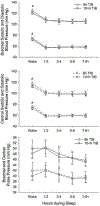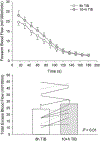Effect of five nights of sleep extension on peripheral vascular function: a randomized crossover investigation into long sleep duration
- PMID: 35180478
- PMCID: PMC8923941
- DOI: 10.1016/j.sleep.2022.01.021
Effect of five nights of sleep extension on peripheral vascular function: a randomized crossover investigation into long sleep duration
Abstract
Long sleep duration, defined as ≥9 h, is associated with increased cardiovascular mortality. We sought to determine the effect of sleep extension on peripheral vascular health. Twelve middle-aged adults were randomly assigned to spend five nights with 8 h (control) or 10+ hours time in bed (TIB) in a crossover fashion. Sleep was assessed using wrist actigraphy. Peak reactive hyperemia in the forearm was measured using venous-occlusion plethysmography as an index of microvascular vasodilation. Nighttime and morning blood pressure was recorded along with pulse wave velocity (arterial stiffness). Average sleep duration was 7.1 ± 0.3 and 9.3 ± 0.3 h for 8 and 10+ hours TIB (P < 0.001), respectfully. On average, sleep was extended by 127 ± 29 min with nine participants reaching average sleep durations >9 h. Extended sleep did not change nighttime or morning blood pressure, or pulse wave velocity (all P > 0.05). In contrast, peak forearm vascular conductance (FVC, 0.27 ± 0.08 vs. 0.23 ± 0.07 ml/100 ml/min/mmHg, P = 0.02) and total excess blood flow (28 ± 9 vs. 24 ± 11 ml/100 ml, P < 0.01) were increased following sleep extension. The change in FVC and total excess blood flow were inversely correlated with the change in wake after sleep onset and TIB (both r = -0.62, P < 0.05), but not with sleep duration. These results demonstrate that extended time in bed accompanied by long sleep durations does not impair peripheral vascular function, but rather, may increase microvasculature vasodilatory capacity in midlife adults.
Keywords: Arterial stiffness; Blood pressure; Reactive hyperemia; Sleep duration; Sleep extension; Vasodilation.
Copyright © 2022 Elsevier B.V. All rights reserved.
Conflict of interest statement
Conflicts of Interest
The authors have no conflicts of interest, financial or otherwise, to declare.
Figures




Similar articles
-
The Effect of Acute Sleep Extension on Blood Pressure Is Dependent on the Change in Sleep Efficiency.Clocks Sleep. 2024 Oct 4;6(4):546-556. doi: 10.3390/clockssleep6040036. Clocks Sleep. 2024. PMID: 39449310 Free PMC article.
-
Effect of acute maximal exercise on vasodilatory function and arterial stiffness in African-American and white adults.J Hypertens. 2019 Jun;37(6):1262-1268. doi: 10.1097/HJH.0000000000002049. J Hypertens. 2019. PMID: 30870268 Free PMC article.
-
Forearm vascular reactivity and arterial stiffness in asymptomatic adults from the community.Hypertension. 2008 Jun;51(6):1512-8. doi: 10.1161/HYPERTENSIONAHA.107.106088. Epub 2008 Apr 21. Hypertension. 2008. PMID: 18426995 Free PMC article. Clinical Trial.
-
Endothelial dysfunction in obstructive sleep apnea measured by peripheral arterial tone response in the finger to reactive hyperemia.Sleep. 2005 May;28(5):594-600. doi: 10.1093/sleep/28.5.594. Sleep. 2005. PMID: 16171272
-
Reduction in peripheral arterial stiffness after reactive hyperemia is dependent on increases in blood flow.Physiol Rep. 2023 Dec;11(24):e15894. doi: 10.14814/phy2.15894. Physiol Rep. 2023. PMID: 38110700 Free PMC article.
Cited by
-
Association of Sleep Duration and Change Over Time With Imaging Biomarkers of Cerebrovascular, Amyloid, Tau, and Neurodegenerative Pathology.Neurology. 2024 Jan 9;102(1):e207807. doi: 10.1212/WNL.0000000000207807. Epub 2023 Dec 13. Neurology. 2024. PMID: 38165370 Free PMC article.
-
The Effect of Acute Sleep Extension on Blood Pressure Is Dependent on the Change in Sleep Efficiency.Clocks Sleep. 2024 Oct 4;6(4):546-556. doi: 10.3390/clockssleep6040036. Clocks Sleep. 2024. PMID: 39449310 Free PMC article.
-
The Effects of Experimental Sleep Extension in Middle-to-Older-Aged Healthy Sleepers.Sleep Sci. 2024 Jun 13;17(4):e357-e369. doi: 10.1055/s-0044-1782525. eCollection 2024 Dec. Sleep Sci. 2024. PMID: 39698175 Free PMC article.
References
-
- Stenholm S, Head J, Kivimäki M, et al. Sleep duration and sleep disturbances as predictors of healthy and chronic disease-free life expectancy between ages 50 and 75: A pooled analysis of three cohorts. Journal of Gerontology, Series A: Biological Sciences and Medical Sciences. 2019;74:204–10. - PubMed
Publication types
MeSH terms
Grants and funding
LinkOut - more resources
Full Text Sources

